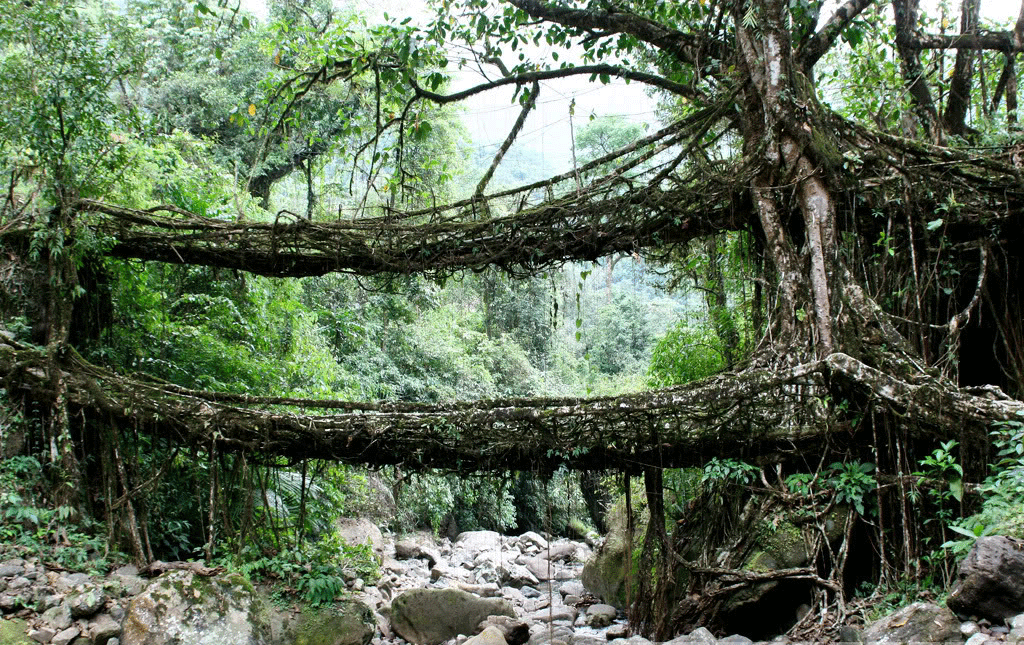The grove game
I tried to imagine what Arboreal culture and recreation would be like, and I ended up designing a lemur sport. I don't know what to call it, so I'll just refer to it as "the grove game."
The premise of the grove game is conceptually similar to basketball or soccer, in that it involves two teams attempting to score on goals on opposite sides of the field of play. However, as distinct from these human sports, the grove game is not played on a flat field or court, but on a "grove" of vertical posts (layout diagrammed below, shown from above), and players jump from post to post to advance toward a single goalpost at either end of the grove (the red dots in the diagram). Points are scored by striking a marked section of the goalpost with a short stick or baton of cane bamboo. The baton may be tossed or handed from player to player, and goals can be scored by either throwing the baton at the marked section, or jumping to the goalpost and tapping the marked section with the baton, with the latter being worth more points.
A unique characteristic of the grove game is the style of movement: players are not allowed to drop to the ground. Only discreet movements between posts are allowed, which makes the tactics of the game similar, in many ways, to the tactics of board games such as chess and checkers. Only two players can occupy a single post at a single time, and a variable set of rules determines how these players can interact, and determines which of the two can jump off the post first. The defense stops the offense and gains possession of the baton by occupying the same post as the baton carrier. The defense can also score points by trapping the baton carrier in a manner similar to "checkmate" in chess (by occupying all adjacent posts the carrier could jump to).
The grove game is played by several ring-tailed lemur cultures of Madagascar and Mozambique. The skills of jumping, climbing and throwing originate in the ancient hunting traditions of several primitive cultures, which used throwing sticks and tactical positioning along tree corridors as part of an arboreal ambush hunting style. Similar tactics were used in training and in warfare, and were eventually adapted for recreation.

I tried to imagine what Arboreal culture and recreation would be like, and I ended up designing a lemur sport. I don't know what to call it, so I'll just refer to it as "the grove game."
The premise of the grove game is conceptually similar to basketball or soccer, in that it involves two teams attempting to score on goals on opposite sides of the field of play. However, as distinct from these human sports, the grove game is not played on a flat field or court, but on a "grove" of vertical posts (layout diagrammed below, shown from above), and players jump from post to post to advance toward a single goalpost at either end of the grove (the red dots in the diagram). Points are scored by striking a marked section of the goalpost with a short stick or baton of cane bamboo. The baton may be tossed or handed from player to player, and goals can be scored by either throwing the baton at the marked section, or jumping to the goalpost and tapping the marked section with the baton, with the latter being worth more points.
A unique characteristic of the grove game is the style of movement: players are not allowed to drop to the ground. Only discreet movements between posts are allowed, which makes the tactics of the game similar, in many ways, to the tactics of board games such as chess and checkers. Only two players can occupy a single post at a single time, and a variable set of rules determines how these players can interact, and determines which of the two can jump off the post first. The defense stops the offense and gains possession of the baton by occupying the same post as the baton carrier. The defense can also score points by trapping the baton carrier in a manner similar to "checkmate" in chess (by occupying all adjacent posts the carrier could jump to).
The grove game is played by several ring-tailed lemur cultures of Madagascar and Mozambique. The skills of jumping, climbing and throwing originate in the ancient hunting traditions of several primitive cultures, which used throwing sticks and tactical positioning along tree corridors as part of an arboreal ambush hunting style. Similar tactics were used in training and in warfare, and were eventually adapted for recreation.
Last edited:

